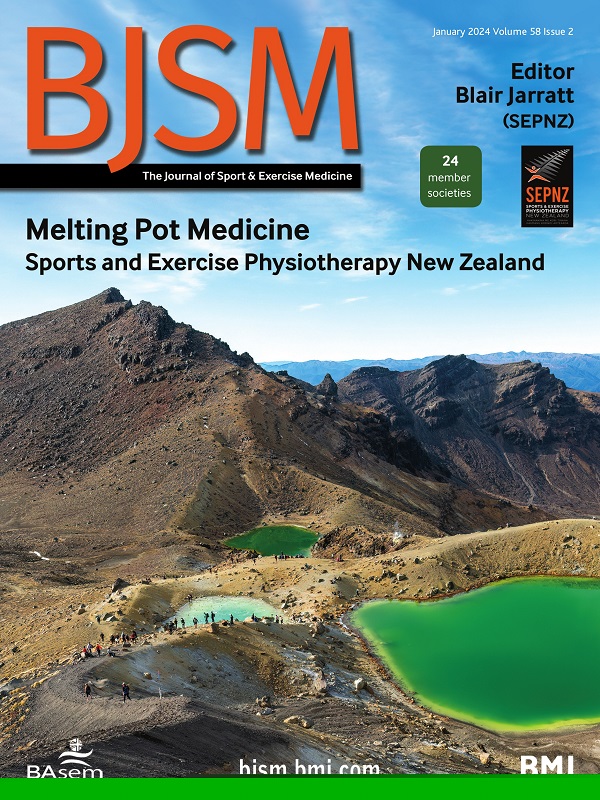使用实时数据捕获策略和主题内研究来更好地理解身体活动健康悖论
IF 16.2
1区 医学
Q1 SPORT SCIENCES
引用次数: 0
摘要
越来越多的证据表明,尽管休闲时间体力活动(LTPA)(即为运动和娱乐而进行的体力活动)会导致心血管疾病(CVD)的阳性结果,但职业体力活动(OPA)(即在工作中进行的活动)可能不会降低心血管疾病发病率和死亡率的风险。LTPA和OPA对健康的潜在矛盾影响被称为身体活动健康悖论1OPA和LTPA发生在不同的背景和环境中,可能对心脏代谢健康风险有不同的影响。LTPA通常由更大范围的身体运动组成,这些运动的强度足以改善心肺健康和新陈代谢,是自愿进行的,通常持续时间较短,两次发作之间有足够的恢复时间。另一方面,OPA通常包括静态负荷、举起重物、重复或痛苦的身体运动和姿势、持续时间长(8 ~ 8小时)且控制力差,以及两次发作之间的恢复期不足,这可能会减弱健康益处或可能增加健康风险。对于许多少数民族和低收入人群来说,清洁、零售、烹饪和老人/儿童保育等职业构成了美国和其他发达国家OPA的常见设置。虽然来自社会经济不利背景的个人每天在从事这些职业的大部分时间里都在进行体力活动,但与收入较高的人相比,他们的健康状况相对较差OPA可能是造成健康差异的一个原因,但目前尚未得到很好的理解。少数民族和……本文章由计算机程序翻译,如有差异,请以英文原文为准。
Using real-time data capture strategies and within-subject studies to better understand the physical activity health paradox
Growing evidence suggests that although leisure time physical activity (LTPA) (ie, performed for sports and recreation) leads to positive cardiovascular disease (CVD) outcomes, occupational physical activity (OPA) (ie, activity occurring at work) may not decrease the risk of CVD morbidity and mortality. The potentially contradictory health effects of LTPA and OPA are referred to as the physical activity health paradox.1 OPA and LTPA occur in different contexts and settings that may differentially contribute to cardiometabolic health risk. LTPA typically consists of a wider range of body movements performed at levels that are sufficiently intense to improve cardiorespiratory fitness and metabolism, is performed voluntarily, and often occurs over shorter durations with adequate recovery time in between episodes. On the other hand, OPA typically includes static loading, lifting heavy objects, repetitive or painful body movements and postures, long durations (>8 hours) with low control, and inadequate periods of recovery in between episodes, which may attenuate health benefits or possibly increase health risks. For many minority and low-income populations, occupations such as cleaning, retail, cooking and elder/childcare constitute a common setting for OPA in the USA and other developed nations. Although individuals from socioeconomically disadvantaged backgrounds are physically active for large portions of each day performing these types of occupations, they remain in relatively poor health compared with their higher-income counterparts.2 OPA may represent a cause of health disparities that is not well understood. Minority and …
求助全文
通过发布文献求助,成功后即可免费获取论文全文。
去求助
来源期刊
CiteScore
27.10
自引率
4.90%
发文量
217
审稿时长
3-8 weeks
期刊介绍:
The British Journal of Sports Medicine (BJSM) is a dynamic platform that presents groundbreaking research, thought-provoking reviews, and meaningful discussions on sport and exercise medicine. Our focus encompasses various clinically-relevant aspects such as physiotherapy, physical therapy, and rehabilitation. With an aim to foster innovation, education, and knowledge translation, we strive to bridge the gap between research and practical implementation in the field. Our multi-media approach, including web, print, video, and audio resources, along with our active presence on social media, connects a global community of healthcare professionals dedicated to treating active individuals.

 求助内容:
求助内容: 应助结果提醒方式:
应助结果提醒方式:


